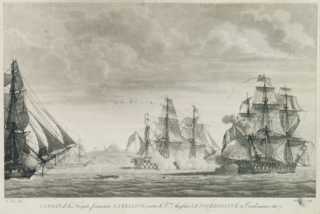Related Research Articles

The Océan-class ships of the line were a series of 118-gun three-decker ships of the line of the French Navy, designed by engineer Jacques-Noël Sané. Fifteen were completed from 1788 on, with the last one entering service in 1854; a sixteenth was never completed, and four more were never laid down.

The Téméraire-class ships of the line were a class of a hundred and twenty 74-gun ships of the line ordered between 1782 and 1813 for the French navy or its attached navies in dependent (French-occupied) territories. Although a few of these were cancelled, the type was and remains the most numerous class of capital ship ever built to a single design.
Five ships of the French Navy have carried the name Africaine:

The Iphigénie class was a group of nine 32-gun/12-pounder frigates of the French Navy, built during the late 1770s at Lorient and Saint Malo. They were designed by Léon Guignace. The seven built at Saint Malo were initially numbered Nos. 1 – 7 respectively, and not given names until October 1777 and the start of 1778 ; all seven were captured by the British Navy between 1779 and the end of 1800. Of the two built at Lorient, the Spanish captured one, and a storm wrecked the other.
Four ships of the French Navy have borne the name Impérial or Impériale:
Jean-Jacques Magendie was a French Navy officer. He famously captained the flagship Bucentaure at the Battle of Trafalgar.

HMS Active was a 28-gun Coventry-class sixth-rate sailing frigate of the Royal Navy, launched in 1758. She was one of the captors of the Spanish ship Hermione. After Hermione surrendered, her captors found that she carried a large cargo of gold and silver that would lead to the greatest single amount of prize money awarded to the crew of a British warship.
Twelve ships of the French Navy have borne the name Entreprenant and four Entreprenante, after the French word for "enterprising"
Utile was a gabarre of the French Royal Navy, launched in 1784. The British captured her in the Mediterranean in 1796 and she served briefly there before being laid up in 1797 and sold in 1798.
René Lemarant de Kerdaniel was a French naval officer who rose to the rank of admiral.
Vésuve was an 18-gun Etna-class corvette of the French Navy, launched in 1795. She was decommissioned in 1815 and broken up in 1830.
Courageuse was a 12-pounder Concorde class frigate of the French Navy. She was launched in 1778. The British captured her in 1799 and thereafter used her as a receiving ship or prison hulk at Malta before breaking her up in 1802.
The Minerve class was a type of 40-gun frigate of the French Navy, carrying 18-pounder long guns as their main armament. Six ships of this type were built at Toulon Dockyard, and launched between 1782 and 1794. The frigates served the French Navy briefly during the French Revolutionary Wars. The Royal Navy captured all six between 1793 and 1799 and took them into service, with all but one serving in the Napoleonic Wars, and some thereafter.
HMS Plumper was a later Archer-class gun-brig of the Royal Navy, launched in 1804. The French captured her in 1805 and took her into their Navy under her existing name. Between 1814 and 1815 her name alternated between Plumper and Argus, finally settling on Argus. As Argus she sailed to Senegal in 1816 in company with Méduse, whose shipwreck gave rise to a famous painting. In 1818 Argus was assigned to colonial service. She was condemned in October 1822 at Saint-Louis, Senegal, and struck in 1827.
Seven ships of the French Navy have borne the name Sans-Culotte in honour of the Sans-culottes:

The French ironclad Valeureuse was one of 10 Provence-class armored frigates built for the French Navy during the 1860s. Commissioned in 1867, she was initially assigned to the Northern Squadron, but was soon transferred to the Mediterranean Squadron, often serving as a flagship. The ironclad played a minor role in the Franco-Prussian War of 1870–1871, blockading the North Sea coast of Prussia and later a Prussian commerce raider in a neutral Spanish port. Valeureuse was reduced to reserve after the war, but was reactivated in 1875 and assigned to the Northern Squadron. The ship was decommissioned two years later and was stricken in 1886. She was scrapped in 1888.

Alexandre was ordered as a third-rank, 90-gun sailing Suffren-class ship of the line for the French Navy, but was converted to a steam-powered ship in the 1850s while under construction. Completed in 1857 the ship participated in the Second Italian War of Independence two years later. Her engines were removed in 1871 and she began conversion into a transport for exiled prisoners. Alexandre was instead completed as a gunnery training ship in 1872. She was hulked in 1877 and served as a barracks ship until she was scrapped in 1900.
Redoubtable was one of five second-rank, 90-gun, steam-powered Algésiras-class ships of the line built for the French Navy in the 1850s. The ship participated in the Second Italian War of Independence in 1859 and was scrapped in 1873–1874.
Twenty-two ships of the French Navy have borne the name Actif ("Active"):
Lutin was a Hasard-class brig-aviso launched at Bayonne in 1788 for the French Navy. Shortly after the outbreak of war with England, the British Royal Navy captured her off Newfoundland. The British took her into service as HMS Lutin. After some two years on the Newfoundland station Lutin sailed to Plymouth where the Navy sold her.
References
- Roche, Jean-Michel (2005). Dictionnaire des bâtiments de la flotte de guerre française de Colbert à nos jours. Vol. 1. Group Retozel-Maury Millau. pp. 23–24. ISBN 978-2-9525917-0-6. OCLC 165892922.
- Winfield, Rif & Stephen S Roberts (2015) French Warships in the Age of Sail 1786 – 1861: Design Construction, Careers and Fates. (Seaforth Publishing). ISBN 9781848322042